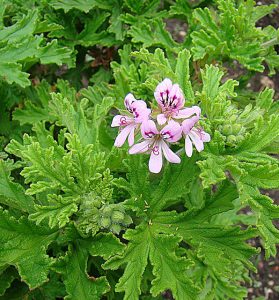By Barbara Crookshanks
Scented geraniums' modest flowers are almost invisible among the big blossoms of their flamboyant cousins...but their fragrant leaves made them the secret stars of Victorian Valentine bouquets.
"Once no bouquet was deemed complete without a bit of this fragrant foliage," wrote Louise Beebe Wilder in her 1932 classic, The Fragrant Path. She suggested using the leaves as "a delightful frill" for a bunch of sweet peas or stocks or combining rose geraniums and nasturtiums for a stimulating nosegay.
Scented geraniums' aromas range from sweet rose to pungent cinnamon. They had an honored place in Kate Greenaway's The Language of Flowers with the rose geranium meaning "preference;" the lemon, "unexpected meeting;" the nutmeg, "expected meeting."
In their 19th-century heyday, scented geraniums (pelargonium) were grown in hundreds of varieties. Their scents included rose, lemon, lime, orange, filbert, nutmeg. almond, apple, anise, pine, musk, violet, lavender, balm, oak, and peppermint.
They sailed to England about 1795 from the Cape of Good Hope via the British fleet. England fell in love with them both for their rainbow of fragrances and their practical uses. The rose geranium could mimic the costly attar of roses' famed scent.
Scented geraniums starred in horticultural shows and were ideal to scent sachets and potpourri. The leaves floated gracefully in crystal finger bowls.
The plants were - and are - easy to grow. Contentment for scented geraniums means fertile, well-drained soil, fairly cool temperature, and full sun. They propagate easily from cuttings. Pinch them back during their growing seasons. Found today in specialty nurseries and catalogs, they become house plants during winter months.
The little plants with the sweet leaves soon arrived in the United States and were highly popular well into the early 20th century. In his 780-page Household Discoveries: An Encyclopaedia of Practical Recipes and Processes, published in 1908, Sidney Morse advises good housekeepers to use bags of "odorous leaves," including those of scented geraniums, to assist in preserving linens from the attacks of insects.
The "sweet leaves" added delightful and inexpensive flavors to cookery on both sides of the Atlantic. Virginia ladies placed a scented rose geranium leaf in each jelly glass before pouring in the boiling syrup. They also made several flavors of sugar by placing scented geranium leaves in their sugar jars.
As years passed, scented geraniums gradually became as out of style as the pompadour and the wasp waist. Louise Beebe Wilder credited their downfall to the popularity of their large and colorful cousins, the bedding geraniums which filled flower beds with "solid blocks of red and pink and white."
However, she predicted that her favorite little plants would take their places in the sun again. Her prediction slowly seems to be coming true.
Isabel Gordon Curtis featured a recipe for Rose Geranium Cake in Mrs. Curtis's Cook Book, which was published in the same huge volume as Mr. Morse's Household Discoveries. She was a noted food editress who served on the editorial staffs of Good Housekeeping, Collier's Weekly, the Delineator and Success magazine.
Isabel Gordon Curtis's Rose Geranium Cake
1/2 cup butter
1 cup sugar
2/3 cup water
2 cups flour
1/4 teaspoon salt
1 teaspoon baking powder (Calumet)
Whites of 4 eggs
Sift flour, salt and baking powder together. Cream butter and sugar. Add alternately water and flour mixture, then whites of eggs. Whip hard 5 minutes. Line loaf pan with buttered paper and rose geranium leaves. Carefully add cake batter. Bake at 350 degrees until it tests done. The geranium leaves can be pulled off with the paper. Note: To intensify the rose flavor, add a few drops of rose extract to the cake batter. You can also use scented geranium leaves when making a standard pound cake recipe.
Learn more about scented geraniums in the library.
Growing & Using Scented Geraniums
Houseplants for A Healthy Home (see South African Geranium)
Here are some additional recipes that use scented geraniums as ingredients:
Berries with Geranium Cream from Epicurious
Citrus-Scented Geranium Cookies from Taste of Home
Rose Geranium Ice Cream with Pistachios from Kitchn
Scented-Geranium Lemonade from The Splendid Table
Wild Apple and Rose Geranium Jelly from Along the Grapevine
In the video below, you can learn how to take scented geranium cuttings from a large plant to make more.


